You might be familiar with the struggle of “so many goals, so little time.” It’s as if you’re always chasing the next big win, but you’re not sure what collecting these wins will accumulate to. Or maybe you’re overwhelmed with the steps needed to make this dream a reality, and you drop off in organizing your next moves.
We are often taught to make goals but not how to design them toward a path to success. What if your confusion could be resolved on a single page? It’s called a goal chart.
Vision is everything, as the saying goes. And creating a goal chart that’s unique to your life purpose is one step towards it.
Types of goal charts
We’re all unique in the way we function, so what works for one of us may not work for another. That’s the beauty of choices—we have the option of choosing what works for us.
And that goes for goal charts. Here are a few common types—try each and see which one can help you take consistent steps toward your overall vision.
Excel goal chart
In the world of goal tracking, your spreadsheet is your canvas. Take full advantage of automation features available nowadays to best visualize your progress over time.
Here are some tips on how to make a goal chart in Excel or Google Sheets:
Tip 1: Digitally map out your tasks over time
If, for example, you want to see a year’s progress in one to three desktop scrolls:
- Step 1: Break down 12 months into sections of weeks.
- Step 2: Then, horizontally line up your weekly sections from Monday to Sunday.
- Step 3: Perpendicularly, write out a habit that will help you reach your goals.
- Step 4: Add daily check boxes for ticking off to identify task completion
With a full year’s view, you can strategize how these tasks could potentially increase in the coming months or quarters. The best part is that copy-pasting and expanding your chart takes away from the manual labor of goal planning and allows you to focus on the actual work.
Here’s an example of an Excel goal tracker:
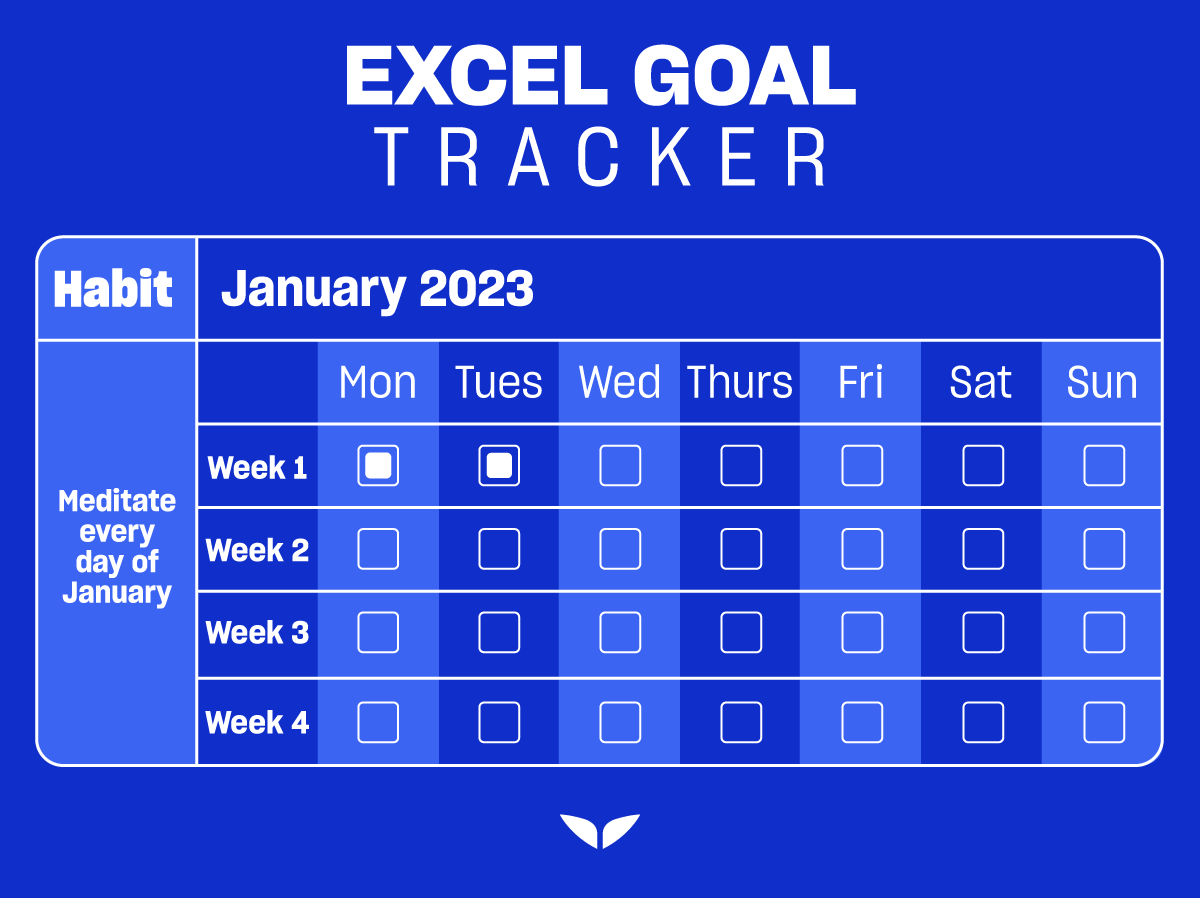
Tip 2: Status updates
Have an overload of tasks to keep in mind? Create progress checks on Excel from “Not started” to “In progress” to “Completed” and everything else in between. This simple Excel hack will improve how you visualize and monitor your progress.
You can maximize this feature by adding color conditions to help you understand your task completion in one glance. For example, use red for “Not Started,” yellow for “In Progress,” and green for “Completed.”
On a broader scale, color conditioning by status will help you see which colors dominate your chart and grant you a pulse check on the health of your efforts.
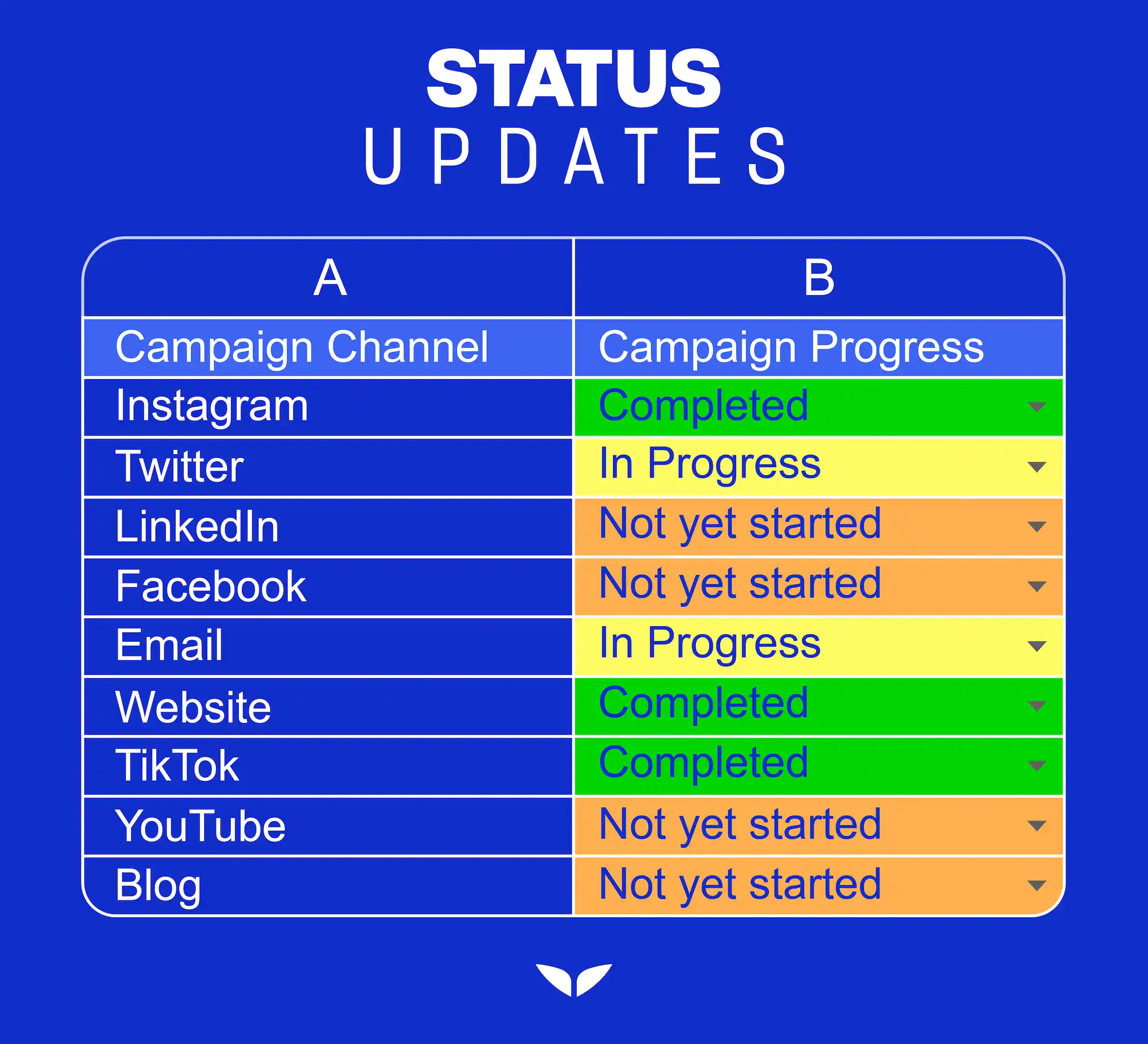
Tip 3: Use Benchmarks
Designing your Excel goal chart with benchmarks works best for tracking numerical measures of success over time. It is ideal for losing weight, decreasing phone usage, and shortening processing time.
Use the system to calculate a benchmark of your average performance so that you can always compare your current performance update to the standard. You can maximize this feature by automating a conditional format that assigns a specific cell color to a range of numbers.
Use this chart when: You want to embed basic tech with your personal growth. Track your growth digitally and reap the benefits of self-automation.
Thermometer goal chart
“Is the glass half empty or half full?” is a commonly used expression to gauge pessimism or optimism. In the case of the thermometer goal chart, this question best encapsulates the kind of information this chart provides—visual communication.
If lines and charts don’t compel you, use the thermometer goal chart to visualize your cumulative live progress over time.
Use this goal chart when: you want to set goals with a team or when visuals best inspire you.
Here’s an example of a thermometer goal tracker:
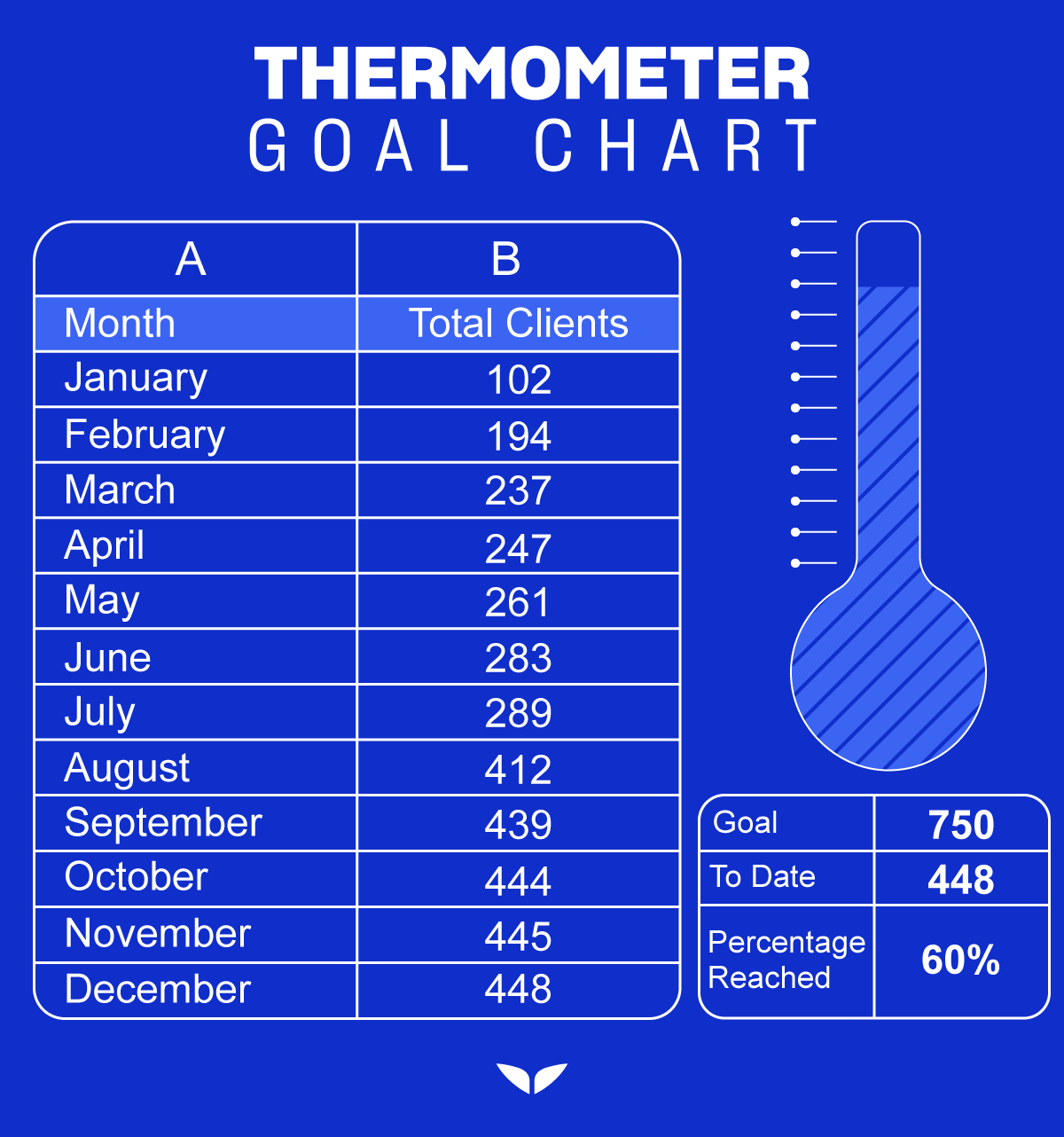
Weight loss goal chart
One of the most important factors that contribute to weight loss is how and what you eat. Other critical elements include correct physical exercise, social influences, sleep, and mindfulness practices.
So it’s a good idea to select the best diet practices and habits to optimize weight loss for you. Create a goal chart that consistently strings these habits along a weekly timeline, and track how much weight you lose as you keep showing up for yourself with this pattern.
Use this goal chart when: You want to craft your optimal recipe for weight loss success.
Here’s an example of a weight-loss goal tracker:
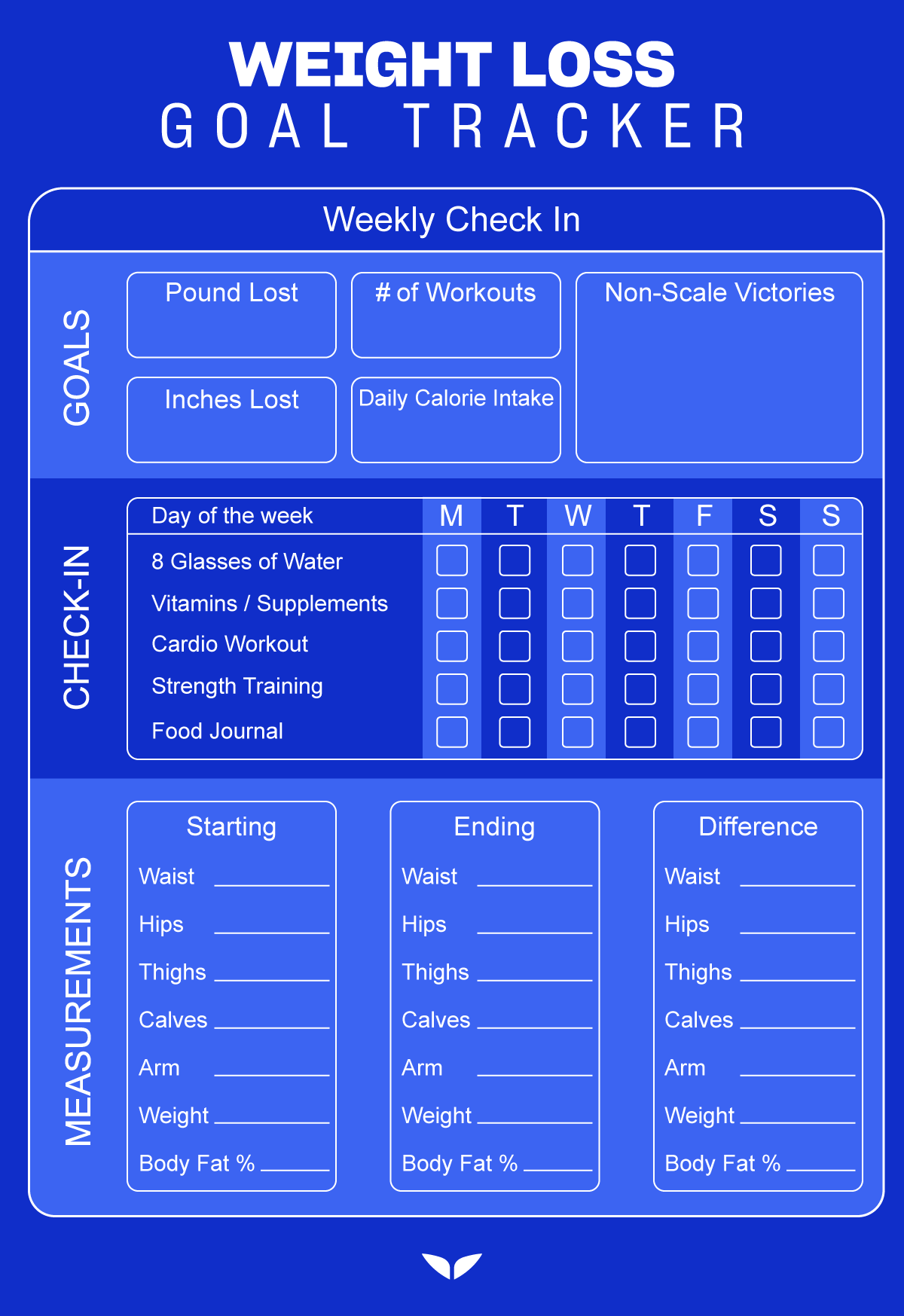
Money management goal chart
If you have a financial goal and a deadline to achieve it, the most diligent approach to financial management is to track how much money comes in and goes out.
Here’s how to structure a goal chart for money management:
- Step 1: Break down your chart into three columns: earnings, expenses, and current balance.
- Step 2: Subtract the value of your expenses from your earnings to find the value of your current balance.
- Step 3: Decide on the frequency of tracking earnings, expenses, and current balance. Will it be daily, weekly, or monthly?
- Step 4: Work backward and calculate the average current balance needed on a consistent basis to achieve your financial goal.
From here, you can monitor if you are progressively on or off track with your financial goals.
Use this goal chart when: You want to achieve a certain amount of money, and you want to evaluate how much you spend and save regularly.
Here’s an example of a money management goal tracker:
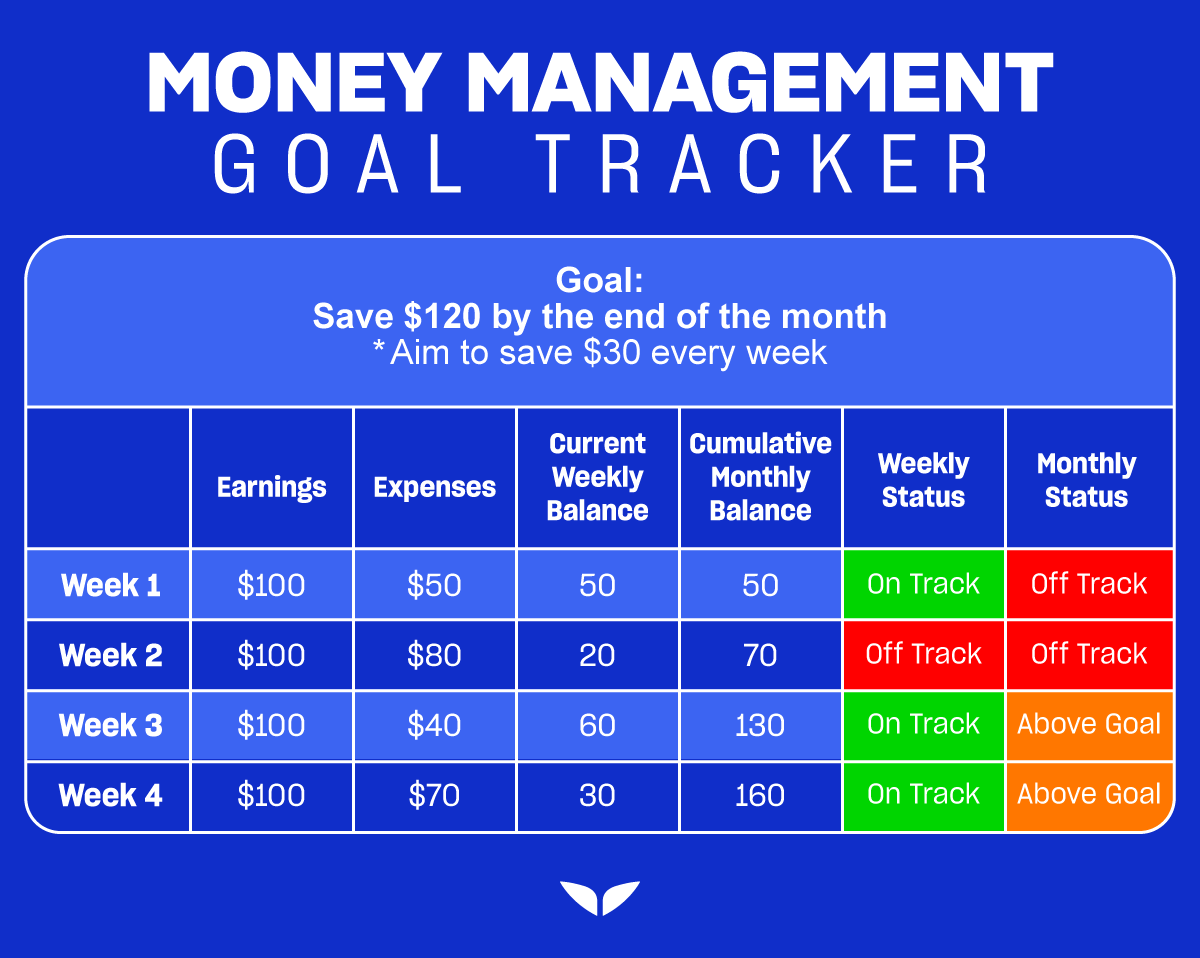
How do you create a goal chart?
The key to staying motivated and reaching your goals is consistency and meticulous tracking of your goal charts. However, your personal goal tracker is more than plotting out the rows and columns; it’s understanding why you should track the tasks, scores, and statuses within them.
Where can you start? Here are three steps to help you create your goal tracker:
1. Define your goals
Getting overwhelmed with the many dreams you have in life is normal. It may even lead to being stuck in life with a case of analysis paralysis.
So it helps to categorize your goals into different life aspects. Jon and Missy Butcher, trainers of Mindvalley’s Lifebook Online Quest, identified 12 aspects of life to focus on:
- Health and Fitness
- Intellectual
- Emotional
- Character
- Spiritual
- Love relationship
- Parenting
- Social
- Career
- Financial
- Quality of life
- Life Vision
Jon and Missy’s formula for living an extraordinary life is tried and tested and has helped many students reach their dreams. Their most central piece of advice? Define your goals by first clarifying your life vision.
The first 11 areas have one goal statement each, and the twelfth is a round-up of all of them.
Why? “When you take the time to define an overall vision for your life that takes into consideration all the important aspects of your life, and then you set goals against that, what that does is it aligns all of your goals, they’re all moving in the same direction,” shares Jon. “They’re all working toward the same thing.”
2. Set a deadline
When it comes to living the life of your dreams, Jon asks the powerful question, “Do you want to get there or live there?”
Your goals are what help you get there because they help you reach for things you don’t have yet. Your healthy habits, on the other hand, are the things you do to sustain these goals. They keep you there.
With this, there are two things to keep in mind:
- Put your goals into habits
- Make your habits sustain your goals
With this feedback loop, Jon suggests you can enjoy the best versions of each aspect of your life—not in the far and long future but right now, automatically, every day. With a healthy level of delaying gratification for the big things, we get to enjoy the little things that lead up to making our dreams and lifestyles a current reality.
So instead of pressuring yourself with a deadline of who you need to be by this year or how much you need to own by this time, ask yourself…
- “What extraordinary habits should I practice?”
- “How frequently do I want to show up to these habits?”
- “How often will I re-evaluate and then uplevel these habits to bring me closer to my desired life?”
Achieving your Life Vision will come down to the goals you set and the habits you practice. That said, Jon and Missy share this brilliant hack for breaking down each habit.
3. Break your goals down into smaller chunks
A life vision? Check. Twelve goal statements per category of life? Check. And a powerhouse attitude to commit to and embrace habits that bring about your best life? Absolutely, check.
Next, all you need is a system to organize these habits. Lifebook’s Goal Chart Template is known as The 12 Sacred Choices. Here’s how it works:
- Choose 12 simple daily behaviors to step into your higher self.
- Track these behaviors daily with a simple binary dot system.
- If you did the task on that day, mark it with a dot, and if you didn’t do the task, leave it blank.
- Can’t get it perfect? Keep calm and carry on.
- If you prefer to fill out the checks with a pen and stick it on your wall as a reminder, you can also make this a printable goal chart.
See your goals and how you inch toward them every day.
BONUS: Free downloadable goal chart
Lifebook’s 12 Sacred Choices Goal Chart greatly represents all your dreams from a single perspective.
And to help you get started, we’ve prepared a free downloadable goal chart, curated according to the Lifebook methodology.
While creating a goal chart can be an amazing game plan, it can also seem daunting. So if you have reservations about mapping out your dreams this way, here’s a pros-and-cons chart to help you decide if this chart is for you.
Pros and cons of keeping a goal chart
| PROS | CONS |
| Gain guidance according to your values: Follow a plan that makes time and space for you to cherish the things you value (family, friends, career, etc.). | Lack of variation: Some people crave the element of surprise and spontaneity in their days. |
| Gain freedom from mental exhaustion: Release the urgency of chasing big dreams when you have a set of daily choices programmed for success. | Lack of flexibility: Committing to a singular life outcome may be constricting for some. They want to be open to changing their mind. |
| Gain a trusted process to guarantee your personal growth: Reap the benefits little by little, but the changes are significant over time. | Lack of focus on seizing life-changing moments: Sometimes, it’s the “spur-of-the-moment decisions” that dictate our life. This system focuses on daily moments. |
If you’re curious about this model, you don’t have to start with 12 Sacred Choices straight away. You are the designer of your personal growth, and with that, it’s up to you to decide if this system best works for you.

Great change starts here
Think about the people you admire the most in this life. You don’t have to do a double take to know when someone is genuinely living their dream.
They are marching to the beat of their own drum, not the one that society has projected on them. Not only that, but they act according to their values and treat people with the right set of values. What’s more, they may not have a spreadsheet in their pockets to show you their daily successes, but behind their greatest successes is a decision to start great habits.
And you can take that first step with Jon and Missy Butcher as your guides. Join the free 90-minute Lifebook Online Masterclass with Jon and Missy Butcher and kickstart your path to designing your best life.
Welcome in.









